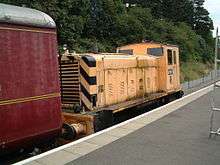British Rail Class 97/6
The British Rail Class 97/6 0-6-0 diesel shunting locomotives were purpose-built for departmental duties by Ruston & Hornsby at Lincoln in 1953 (97650) or 1959 (97651-654). There are minor technical differences between 97650 and the 1959 batch.
| British Rail class 97/6 | |||||||||||||||||||||||||||||||||
|---|---|---|---|---|---|---|---|---|---|---|---|---|---|---|---|---|---|---|---|---|---|---|---|---|---|---|---|---|---|---|---|---|---|
.jpg) 97651 at Radyr in August 1982. | |||||||||||||||||||||||||||||||||
| |||||||||||||||||||||||||||||||||
| |||||||||||||||||||||||||||||||||
| |||||||||||||||||||||||||||||||||
| |||||||||||||||||||||||||||||||||
This class of five locomotives is outwardly similar to the Class 04 locomotives built around the same time but, internally, they are quite different. The Class 97/6 is diesel-electric while the Class 04 is diesel-mechanical.
Overview

.jpg)
The fleet was originally numbered PWM650-654 in the Western Region Permanent Way Machines series, hence were commonly referred to as the “PWM shunters” or simply “PWMs”.[1] Between 1979 and 1981 they were renumbered as Class 97 locomotives. Originally painted in BR Green livery, this was later superseded by BR Blue and finally Civil Engineering Yellow. They were employed at various locations, including Reading West (97650/653/654), Gloucester / Cardiff Canton / Radyr (97651) and Plymouth Laira (97652).
Specification
- Diesel engine: Ruston 6VPH of 165 bhp (123 kW) at 1,250 rpm
- Transmission: Electric,
- Main generator: 1 x British Thomson-Houston RTB6034
- Traction motor: 1 x British Thomson-Houston RTA5041 (nose-suspended)
- Driving wheel diameter,
- 97650: 3 ft 2½in (978 mm)
- 97651-654: 3 ft 4in (1,016 mm)
- Weight,
- 97650: 28 tons (29 tonnes)
- 97651-654: 30 tons (31 tonnes)
- Maximum tractive effort: 17,000 lb (75 kN)
- Maximum speed: 20 mph (32 km/h)
- Brake type: Straight air on locomotive, automatic vacuum for train
A special feature of this class is that the electric traction motor can be disengaged from the wheels. This allows the locomotive to be hauled by another locomotive at speeds above 20 mph.
Withdrawal
With the privatisation of British Rail these locomotives were largely made redundant. Three locomotives had already been withdrawn from traffic, and only nos. 97651 and 97654 survived long enough to pass into English Welsh & Scottish (EWS) ownership. Number 97654 was sold to an infrastructure company based in Edinburgh, and remained in use until 2005, when it was preserved. Number 97651 was one of the first locomotives sold by EWS into preservation.
Preservation

Three of the five locomotives have been preserved on heritage railways.
- 97650 - Lincolnshire Wolds Railway
- 97651 - Swindon and Cricklade Railway
- 97654 - Heritage Shunters Trust
Incomplete remains of 97653 were stored at the former Ministry of Defence depot at Long Marston, Warwickshire until taken to Hurst's, Andover for scrap in August 2011.[2]
Fleet details
| Key: | Preserved | Scrapped |
|---|---|---|
| Number(s) | Built | Final livery | Withdrawn | Disposal | Notes | |
|---|---|---|---|---|---|---|
| 97650 | PWM650 | 1953 | BR Blue | 1987 | Preserved | |
| 97651 | PWM651 | 1959 | CE Yellow | 1996 | Preserved - Swindon and Cricklade Railway | |
| 97652 | PWM652 | 1959 | CE Yellow | 1987 | Scrapped (1990) | |
| 97653 | PWM653 | 1959 | CE Yellow | 1993 | Scrapped (2011) | |
| 97654 | PWM654 | 1959 | CE Yellow | 2005 | Preserved | |
References
- Booth, A. J. (1992). The PWM’s: A History of the BR Western Region class 97/6 Departmental Shunters. Bridlington: Industrial Railway Society. ISBN 0901096741.
- http://www.wnxx.com/news/index.htm
Sources
- ABC British Railways Locomotives: Combined Volume, Winter 1962/3. London: Ian Allan. 1962. p. 238. ISBN 0711014361.
- Greaves, Simon; Greengrass, Robert, eds. (1998). Locomotive Datafile. Metro Enterprises. p. 99. ISBN 094777310X.
External links
- Heritage Shunters Trust - owners of 97654.
- Information and details on TheRailwayCentre.Com website.
- PWM651 info page at Northampton & Lamport Railway
- departmentals.com
- PWM page at Preserved Shunters